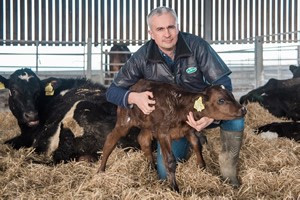 Dairy production in Scotland, like beef, is struggling to be consistently profitable and the clock is ticking on subsidies, writes dairy farmer and NFU Scotland member Rory Christie of Dourie Farm, Newton Stewart, Dumfries and Galloway.
Dairy production in Scotland, like beef, is struggling to be consistently profitable and the clock is ticking on subsidies, writes dairy farmer and NFU Scotland member Rory Christie of Dourie Farm, Newton Stewart, Dumfries and Galloway.
Here in the South West of Scotland myself, Graham Armstrong of Kirvennie Farm and Charlie Russell of Glenapp Estate are farming dairy in a grass-based system. We have tried various innovative practise such as the Lean method of business management, we’re spring block calvers, our inputs are low; we’ve done everything we can to produce more for less and it’s still not enough.
But there’s one aspect we haven’t yet addressed. If Cow A produces more than Cow B in the same system the difference is likely to be genetics. We have reams of herd data and a basic ranking system, and the difference between the best and worst cows is enormous. If we had a herd of the best cows, our worries would be over.
Through the new Rural Innovation Support Service (RISS) we have gained a facilitator, Hamish Walls of SAOS, who is tasked with making our idea a reality. He has brought in genetic scientist Mike Coffey of SRUC who is helping us create a breeding programme that will target not the bull genetics, as is usual, but the female – the dam - genetics. We hope to use genomic testing combined with herd data to accurately rank the cows, then we will trial the best reproductive technologies, such as large-scale embryo transfer, to breed from only the best cows.
What are the possible outcomes? For us, of course, producing more for less means more money in the bank. But a better use of resources – Increasing output from grazed pasture, for example – has genuine environmental benefits when considered alongside carbon sequestration of grass. We hope to achieve carbon and methane neutral systems.
And there are industry wide benefits too. One issue that no-one likes to talk about is dairy bull calves. There’s little or no economic value to them yet the Scottish beef herd is decreasing in number and reduced government support could rapidly increase the rate of decline. Brexit may also mean reduced imports from Ireland, which would deepen the abattoir crisis: we need a new source of animals. If we reduce the number of dairy cows we are breeding to dairy calves, we could target the rest with sexed beef semen increasing beef-cross dairy cattle available for the red meat supply chain. This would help keep the abattoirs’ throughput above critical mass.
If we are successful in finding a commercially viable solution to rapid genetic gain, we could create a step-change across the livestock industry. What’s certain is in farming we must seek out our own answers, not wait for someone to bring them to us. This type of project is what we need to become a robust, thriving industry.
Watch the Speeding Up Dairy Breeding film here.
Rory is speaking at sustainable food and farming organisation Soil Association Scotland’s Future Farming conference on July 12 at the DoubleTree by Hilton Hotel, Dundee 10am to 4pm. Free of charge to all farmers, crofters and land managers.
Includes lunch. Booking required. Book here, call Lyn on 07899 791748 or email lwhite@soilassociation.org
Photo credit: Dan Baillie